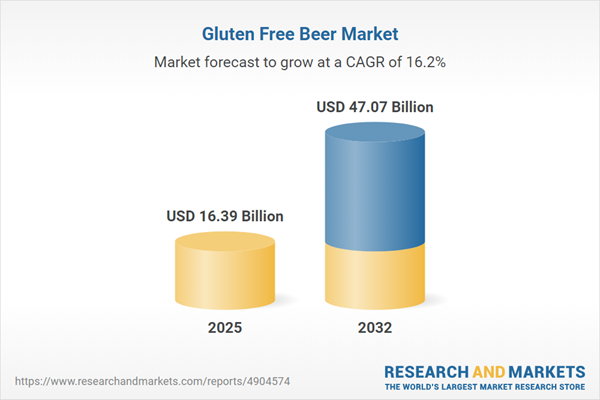Speak directly to the analyst to clarify any post sales queries you may have.
The gluten free beer market is undergoing significant transformation, shaped by evolving health priorities and rapid innovations in brewing. Senior leaders seeking strategic advantage should understand how modern consumer demands, regulatory shifts, and expanding product portfolios are redefining global competition in this high-potential category.
Market Snapshot: Growth & Dynamics
The Gluten Free Beer Market increased from USD 14.13 billion in 2024 to USD 16.39 billion in 2025. With a compound annual growth rate (CAGR) of 16.22%, the sector is set to reach USD 47.07 billion by 2032. Factors such as heightened gluten awareness, premiumization, and investments in brewing technology are propelling growth as both established and emerging brands respond to shifting consumer expectations.
Scope & Segmentation
This report delivers in-depth analysis by segmenting the gluten free beer landscape across multiple critical dimensions:
- Type: Ale (brown ale, IPA, pale ale), lager, pilsner (American, Czech), stout (dry, imperial), wheat beer (American wheat, hefeweizen)
- Packaging: Bottles (330ml, 500ml), cans (330ml, 440ml), kegs (30L, 50L)
- Distribution Channel: Off-trade (convenience stores, specialty stores, supermarkets), on-trade (bars & pubs, hotels, restaurants), online (direct-to-consumer, retailer websites)
- Brand Type: Craft, mainstream, private label
- Price Range: Economy (standard, ultra economy), premium (standard, super premium)
- Alcohol Content: High alcohol (6-8%, >8%), standard (4-6%), low alcohol (low-alcoholic, non-alcoholic)
- Flavor Profile: Fruity, hoppy, malty
- Consumer Age Group: 18-25, 26-35, 36-45, 46+
- Geography: Americas (North America: United States, Canada, Mexico; Latin America: Brazil, Argentina, Chile, Colombia, Peru), Europe, Middle East & Africa (Europe: United Kingdom, Germany, France, Russia, Italy, Spain, Netherlands, Sweden, Poland, Switzerland; Middle East: United Arab Emirates, Saudi Arabia, Qatar, Turkey, Israel; Africa: South Africa, Nigeria, Egypt, Kenya), Asia-Pacific (China, India, Japan, Australia, South Korea, Indonesia, Thailand, Malaysia, Singapore, Taiwan)
- Company Profiled: Anheuser-Busch InBev SA/NV, Damm S.A.U., Mahou-San Miguel, S.A., Omission Brewing Company, LLC, Glutenberg Inc., Brasserie de Brunehaut, Bard's Tale Beer Company, LLC, Ground Breaker Brewing Company, Holidaily Brewing Co., LLC, Brouwerij Anders!Green NV
Key Takeaways for Decision-Makers
- Consumer demand for gluten free beer increasingly extends beyond dietary needs, with emphasis on ingredient transparency and unique taste experiences.
- Innovation in brewing—through specialty grains and advanced enzyme technologies—has broadened product appeal and created new sub-categories, supporting portfolio differentiation.
- Brand success is linked to authenticity, sustainability initiatives, and digital outreach, particularly as packaging and marketing innovations improve in-store and online discoverability.
- Agile production models, such as small-batch releases and co-creation with consumers, enhance responsiveness to rapidly changing market trends.
- Global supply chains require resilience planning, as regulatory adjustments and trade policies can impact input sourcing and long-term costs.
Tariff Impact: U.S. Market Adaptations
2025 United States tariff changes on imported brewing ingredients are prompting manufacturers to reassess sourcing and operational strategies. Breweries are increasingly collaborating with domestic suppliers to secure specialty grains, reducing reliance on imports and mitigating pricing risks. Investments in local infrastructure and supply partnerships are emerging as key strategies for both craft and large-scale producers. The downstream effect will likely be reflected in modest price adjustments, further emphasizing the importance of value communication to end customers.
Methodology & Data Sources
This analysis utilizes a robust research framework blending qualitative interviews with brewing scientists and executives, along with quantitative data from secondary industry sources and regulatory filings. Expert validation and retail channel audits ensure reliability and actionable insight for business leaders navigating the gluten free beer market.
Why This Report Matters
- Provides a strategic lens on innovation, regulatory risk, and regional trends for the gluten free beer industry.
- Helps senior leaders identify targeted growth strategies and anticipate evolving consumer preferences within beverage categories.
Conclusion
As health-driven preferences and regulatory landscapes mature, understanding the interplay of innovation, supply chain agility, and consumer engagement is essential for sustained growth in the gluten free beer segment. This report delivers actionable intelligence for leadership teams focused on positioning their brands for future market success.
Additional Product Information:
- Purchase of this report includes 1 year online access with quarterly updates.
- This report can be updated on request. Please contact our Customer Experience team using the Ask a Question widget on our website.
Table of Contents
3. Executive Summary
4. Market Overview
7. Cumulative Impact of Artificial Intelligence 2025
Companies Mentioned
The companies profiled in this Gluten Free Beer market report include:- Anheuser-Busch InBev SA/NV
- Damm S.A.U.
- Mahou-San Miguel, S.A.
- Omission Brewing Company, LLC
- Glutenberg Inc.
- Brasserie de Brunehaut
- Bard’s Tale Beer Company, LLC
- Ground Breaker Brewing Company
- Holidaily Brewing Co., LLC
- Brouwerij Anders!Green NV
Table Information
| Report Attribute | Details |
|---|---|
| No. of Pages | 190 |
| Published | November 2025 |
| Forecast Period | 2025 - 2032 |
| Estimated Market Value ( USD | $ 16.39 Billion |
| Forecasted Market Value ( USD | $ 47.07 Billion |
| Compound Annual Growth Rate | 16.2% |
| Regions Covered | Global |
| No. of Companies Mentioned | 11 |









